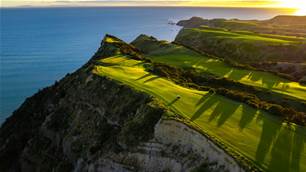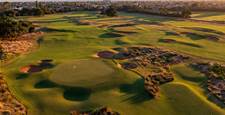Australia’s largest city is blessed with some of the nation’s most famous attractions. After you’re done with the Opera House and Harbour Bridge, here are the dozen highest-ranked courses to be found, all within a 45-minute drive of Sydney’s GPO.
5 ELANORA COUNTRY CLUB
At No.38 in Australia’s Top-100, Elanora is the highest ranked course on Sydney’s idyllic Northern Beaches, which is home to plenty of high quality golf and some of the country’s most famous beaches.
Sitting high above the suburb of Narrabeen a little over 40 minutes from the GPO of Sydney, Elanora features undulating terrain and is surrounded on most sides by dense bush and trees that provide a tranquil setting for the members of the private club and their guests.
Originally designed by Dan Soutar with 18 holes opening for play in 1930, the course underwent a redesign by James Wilcher in 2004, which improved the strategy and conditioning of the layout, while also addressing some safety concerns and incorporating environmental wetlands into the course. The couch fairways and A1 bent greens are consistently among the best to be found in Sydney.
A large exposed rock behind the green immediately grabs first time visitors’ attention at the opening hole, which is one of the standouts on course and does as all good 1st holes should. It provides a window into what to expect throughout the rest of the round, with bunkering and the narrowing of the fairway in the longer hitter’s driving zone delivering the uphill par-4’s main defence.
Similarly, the course’s conclusion leaves golfers wanting more. A par is always a good score at the 394-metre uphill par-4 18th, which requires a well-struck and straight drive from one of Elanora’s many elevated tees to set up the best angle to a green that sits in front of the stately clubhouse.
GREEN FEES: $295 (per person for 18 holes), on application by interstate and overseas players with a letter of introduction from their home club.

6 ROYAL SYDNEY GOLF CLUB
Sifting through the records of the Royal Sydney club reveals the course that now lies a smooth 7-iron hit from the edge of Sydney Harbour in Rose Bay was originally laid out by an unknown designer and more than 360 bunkers dotted the layout.
Some of Royal Sydney’s original architectural work has often mistakenly been attributed to the legendary Dr Alister Mackenzie, who visited the course briefly in 1926. He said the undulating ground was “adaptable to the construction of holes, which should compare favourably with the best championship courses in Britain.”
But he was critical of the penal nature of the course and suggested three-quarters of the bunkers be removed and replaced by grassy hollows. Over the decades, MacKenzie’s words seem to have rung in the ears of the various club committees and more than 200 bunkers were removed.
In 1980, course designers Peter Thomson and Mike Wolveridge redesigned many of the holes and changed all the greens, which was completed in 1986.
Nearly two years after Aaron Baddeley won the 1999 Australian Open on the course, another designer was on site. Acclaimed designer Ross Watson was commissioned to rebuild some holes and all the greens, which were suffering from drainage and turf problems.
The club revealed two years ago that highly-rated American designer Gil Hanse had been commissioned to rebuild the course. Hanse submitted his blueprint for the new Royal Sydney layout but work is yet to commence on realising his vision for the layout, which was ranked No.41 in the country earlier this year.
The course is always beautifully presented and the bunker renovation completed half a dozen years ago did improve the golf experience. But the course, in particular the greens, is ready for Hanse’s upgrade.
GREEN FEES: Upon application for interstate and overseas golfers.

7 TERREY HILLS COUNTRY CLUB
When construction of the Terrey Hills course was completed in 1994, it was the first layout to open in nearly three decades that was less than 30 minutes’ drive from the Sydney CBD.
Its proximity to the city is one of the reasons behind the success of the Graham Marsh-designed layout, which has become one of the most popular corporate golf venues in Sydney.
Another aspect of its success is the quality of the layout – 18 holes of two distinctly different nines that offer plenty of challenges for the better player and a fair, enjoyable round for the average golfer.
This high level of conditioning goes hand-in-hand with Marsh’s outstanding design, which rewards good driving and accurate shot-making from the fairways. Missing any of the large undulating greens presents its own challenges, whether it is a shot from sand, down a deep hollow or the side slope of a mound.
A change of ownership in recent times has seen the standard of presentation maintained, while Marsh was asked to come back and tweak the design of a few holes. The most notable change can be seen at the par-3 12th hole, where the green is now closer to a lake that has always flanked the right edge of the hole. More bunkering has been added to the two original bunkers, found back and right, creating a tough short one-shotter.
GREEN FEES: Guests may only be invited by a member.

8 STONECUTTERS RIDGE GOLF CLUB
The newest course to open in Sydney’s metropolitan area has held a place in the top-50 of this magazine’s national ranking since opening in 2012.
Despite being located 45 minutes’ drive west of the Harbour Bridge, Stonecutters is well-affected by wind – in terms of strength and direction – which was noted by the designers when routing the course.
The Greg Norman design, in what was his last collaboration with former design partner Bob Harrison, takes into account that the prevailing wind varies significantly from season to season and, sometimes, from morning to afternoon. A strong westerly, for example, will be in your favour playing the four par-5s, but the same wind will add some length and bite to the longer par-4s through the middle of the round.
In essence, the routing has become one of the great attributes of the layout as it never plays the same from round-to-round simply because of the wind direction.
Stonecutters Ridge provides mostly spacious fairways where errant drives are punished via awkward approach angles rather than snarly rough. OK, so there’s plenty of that in view, along with water, but most times the penalty for a safety-first play is instead felt when sizing up the next shot. A perfect case is the 343-metre 4th hole, which shares a fairway with the 3rd to the left and is almost as wide as the 1st and 18th holes of the Old Course at St Andrews. But the ideal line here is to skirt the water hazard lining the entire right edge of the fairway to leave a straightforward approach into the long, narrow and angled green. If you play conservatively here and hit your tee shot into the wide expanses to the left, your second shot will be much longer and coming from a difficult angle.
Most good scores are made on the back nine, which carries three of Stonecutters’ four par-5s. But it is the par-4 14th you will long remember. Ranging between 326 and 370 metres, the 14th meanders downhill with a single fairway bunker on the left and a large tree retained in the right side just as the land starts to flatten out. The approach shot is played uphill to a clever green complex with sand on both sides and a steeply two-tiered putting surface, where the top shelf houses the more demanding hole locations while the bottom level has the most fun flags as the step in the green can be used as a backstop.
GREEN FEES: $50 (weekdays); $55 (weekends and public holidays).

Related Articles

Drinks With... Ricky Ponting

International Spotlight: Omanu Golf Club













